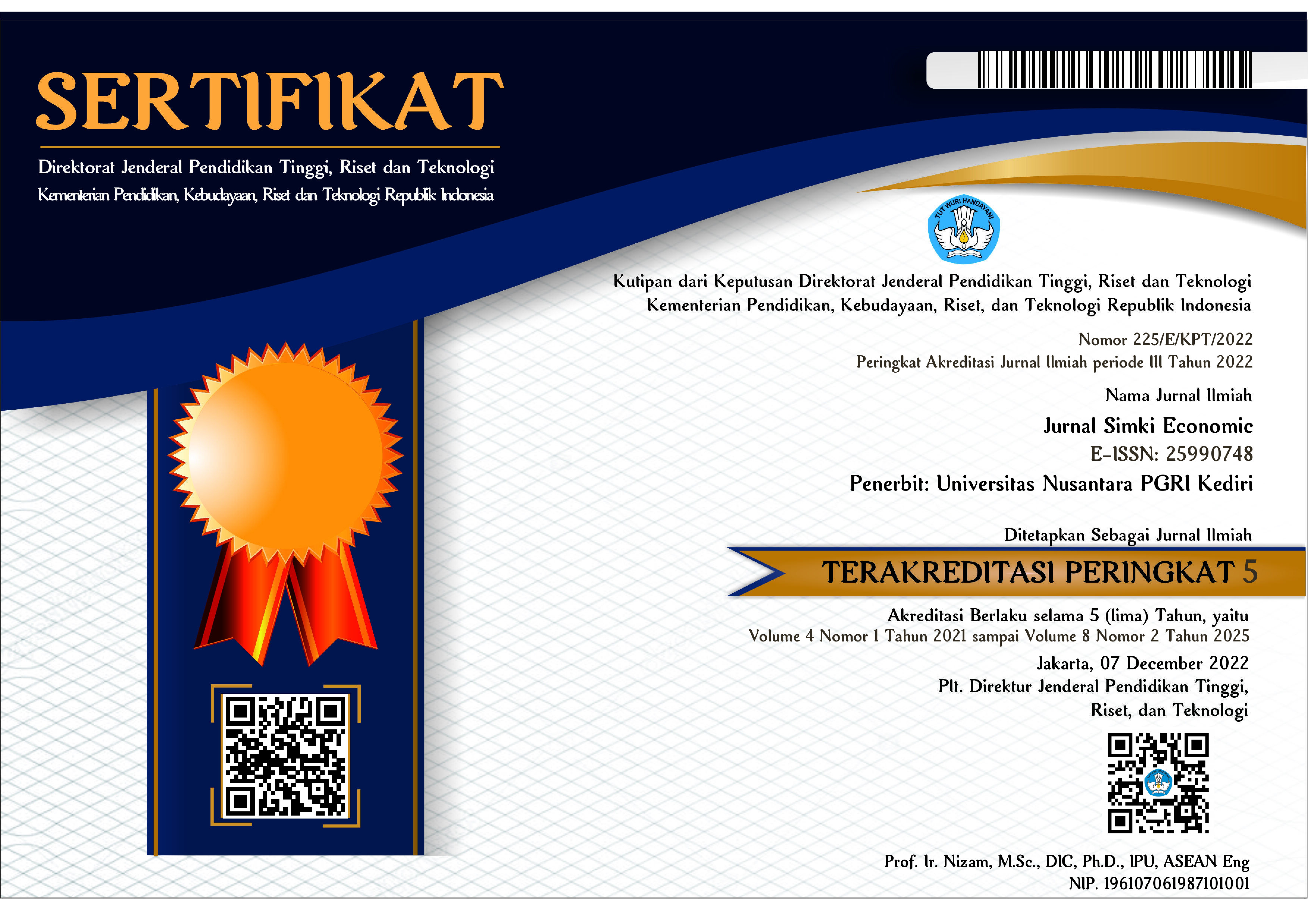Pengaruh Motivasi Kerja, Kompetensi dan Lingkungan Kerja Terhadap Kinerja Karyawan CV Amanda Kediri Tahun 2014
 Abstract views: 228
,
Abstract views: 228
,
 PDF (Bahasa Indonesia) downloads: 172
PDF (Bahasa Indonesia) downloads: 172
Abstract
Human resources in the company have a very important role and function for the achievement of company goals. The company's goals will only be achieved when the employees of the company have good performance. Good and bad employee performance is influenced by several factors, some of which are work motivation, competence, and work environment. This, apparently also experienced by CV Amanda Kediri. This study aims: 1) To determine the effect of work motivation on employee performance CV Amanda Kediri. 2) To determine the effect of work competence on employee performance CV Amanda Kediri. 3) To find out the influence of the work environment on the performance of CV Amanda Kediri employees. 4) To determine the effect of work motivation, work competence and work environment on employee performance at CV Amanda Kediri. This research is descriptive of 30 samples of employees from a total population of 30 employees. The sampling technique used is purposive sampling. Analysis of the data in this study using multiple linear regression analysis using statistical tools, namely SPSS version 17. The results of the study as well as conclusions are: 1) Employee motivation has a significant effect on employee performance. 2) competence has a significant effect on employee performance. 3) The work environment has a significant effect on employee performance. 5) Motivation, competence, and work environment have a significant effect on employee performance. From these conclusions it is recommended the following: 1) because motivation, competence, and work environment have been proven to affect employee performance, CV Amanda Kediri must be able to maintain this and even improve it for the better. 2) from the results of the study, there is still an influence from variables outside those in this study, which is 10.4%, so the results of this study can be used as material for further research by including other variables other than those already included in this study.
Downloads
References
Arcynthia, L.M. 2013. Analisis Pengaruh Kompetensi Terhadap Kinerja Karyawan Pada Pt. Bank Bukopin, Tbk Cabang Makassar. Skripsi. Fakultas Ekonomi dan Bisnis Universitas Hasanudin Makasar.
Colquitt, N. dan Lepine. 2009. Perilaku dalam Organisasi. (Terjemahan Agus Darma), Jakarta: Erlangga.
Dunnet’s, N. 2004. A theory of collective competence challenging the ne-liberal individualisation of Performance at work. Journal of Management Development Vol. 27 No.1, hal.5-7
Durkeim, U. 2003. Riset Sumber Daya Manusia. Jakarta : Gramedia Pustaka Utama.
Gerungan, W.A. 2009. Sumber Daya Manusia dan Produktivitas Kerja. Bandung: CV Mandar Maju.
Ghozali, I. 2005. Aplikasi Analisis Multivariate dengan Program SPSS. BP Semarang : UNDIP
Gitosudarmo, I. dan I Nyoman S. 2008. Perilaku Organisasi. edisi pertama. Yagyakarta : BPFE.
Hafidz. 2012. Pengaruh faktor motivasi, kepuasan kerja, lingkungan kerja dan kemampuan terhadap prestasi kerja karyawan pada The Djayakarta Daira Hotel Palembang. Jurnal Ilmiah. Fakultas Ekonomi Universitas Negeri Padang.
Handoko, T.H. 2000. Manajemen Personalia dan Sumber Daya Manusia.Yogyakrata : BPFE.
Hasibuan, M.S.P. 2009. Manajemen Dasar, Pengertian dan Masalah. Jakarta : Bumi Aksara
Kreitner, R. dan Kinicki, M. 2008. Organizational Behavior. New Jersey : Prentice Hall International.
Luthan, G. and Phill J. 2005. Organization Behavior (Prilaku Organisasi). Yogyakarta : ANDI Offsett
Malthis, R.L. dan John H. 2006. Human Resource Management (Manajemen Sumber Daya Manusia), Edisi Sepuluh. Terjemahan : Diana Angelica. Jakarta : Salemba Empat.
Manullang. 2008. Manajemen Personalia. Jakarta : Ghalia Indonesia.
Mangkunegara, A.P. 2005. Evaluasi Kinerja Sumber Daya Manusia. edisi pertama, cetakan pertama. Bandung : Refika Aditama.
Nitisemito, A.S. 2008. Manajemen Personalia. Yogyakarta : Jendela
Rakhmat, J. 2001. Metode Penelitian Komunikasi. Bandung : PT. Rosdakarya
Rivai, V. 2005. Performance Appraisal, Sistem Yang Tepat Untuk Menilai Kinerja Pegawai Dan Meningkatkan Daya Saing Perusahaan. Jakarta : Rajagrafindo Persada.
Ruky. A.S. 62006. Sistem Manajemen Kinerja: Performance Management System, Panduan Praktis untuk Merancang dan Meraih Kinerja Prima. Jakarta: PT Gramedia Pustaka Utama
Supriyanto, Achmad dan Machfudz, M. 2010. Prosedur penelitian suatu pendekatan praktik. Malang : UIN Maliki
Sedarmayanti. (2001). Sumber Daya Manusia dan Produktivitas Kerja. Bandung: Mandar Maju
Sedarmayanti. (2010). Sumber Daya Manusia dan Produktivitas Kerja. Bandung: Mandar Maju
Siagian, S.P. (2002). Kiat Meningkatkan Produktivitas Kerja. Jakarta: Rineka Jaya.
Simamora, H. 2006. Manajemen Sumber Daya Manusia, edisi keempat, cetakan pertama. Yogyakarta : YKPN
Sugiyono, 2006. Metode Penelitian Kuantitatif, Kualitatif, dan R&D. Bandung: Alfabeta.
Sugiyono. 2011. Metode Penelitian Kuantitaif Kualitatif dan R & D. Bandung : Alfabeta
Sulistiyani A.T. dan Rosidah. 2009. Manajemen Sumber Daya Manusia, Konsep Teori dan Pengembangan Dalam Konteks Organisasi Publik, edisi kedua, cetakan pertama. Jakarta : Graha Ilmu.
Sunardi, R. 2012. Manajemen Sumber Daya Manusia. Jatinangor : Alqaprint.
Sutrisno, E. 2009. Manajemen Sumber Daya Manusia. edisi pertama, cetakan pertama. Jakarta : Kencana Prenada Media Group.
Thoha, M. 2008. Manajemen Sumber Daya Manusia. Jakarta : PT. Raja Grafindo Persada
Wibowo, W. 2011. Manajemen Kinerja. Yogyakarta : Pustaka Pelajar.
Wulandari, J. 2013. Pengaruh Motivasi Kerja dan Kepemimpinan terhadap Kinerja Karyawan Ganysha Bakery Kabupaten Kediri. Skripsi. Fakultas Ekonomi Universitas Nusantara Kediri.
Copyright (c) 2019 Dyah Ayu Rohmawati

This work is licensed under a Creative Commons Attribution 4.0 International License.














